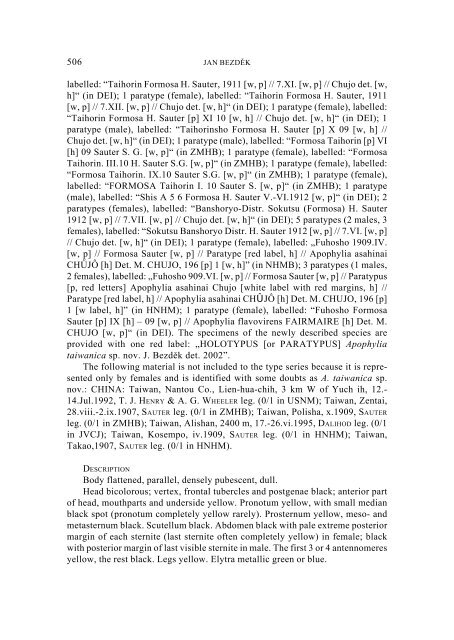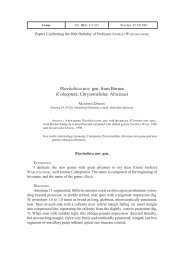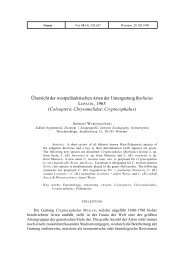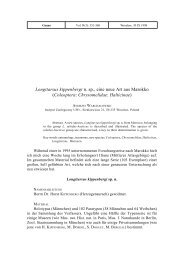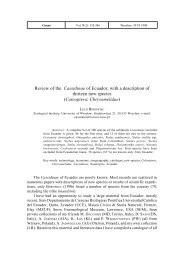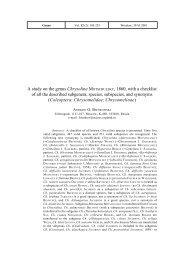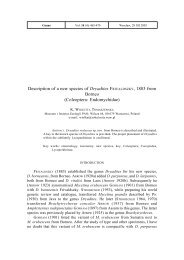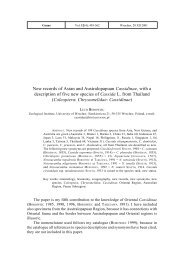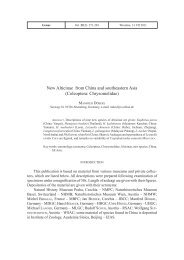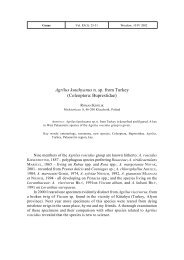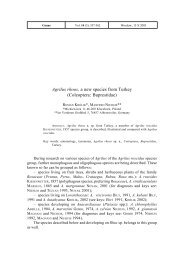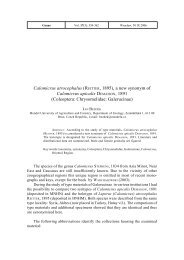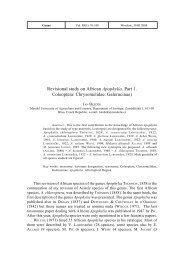Studies on asiatic Apophylia. Part 5: Revisional study of type ...
Studies on asiatic Apophylia. Part 5: Revisional study of type ...
Studies on asiatic Apophylia. Part 5: Revisional study of type ...
You also want an ePaper? Increase the reach of your titles
YUMPU automatically turns print PDFs into web optimized ePapers that Google loves.
506 JAN BEZDÌK<br />
labelled: “Taihorin Formosa H. Sauter, 1911 [w, p] // 7.XI. [w, p] // Chujo det. [w,<br />
h]“ (in DEI); 1 para<strong>type</strong> (female), labelled: “Taihorin Formosa H. Sauter, 1911<br />
[w, p] // 7.XII. [w, p] // Chujo det. [w, h]“ (in DEI); 1 para<strong>type</strong> (female), labelled:<br />
“Taihorin Formosa H. Sauter [p] XI 10 [w, h] // Chujo det. [w, h]“ (in DEI); 1<br />
para<strong>type</strong> (male), labelled: “Taihorinsho Formosa H. Sauter [p] X 09 [w, h] //<br />
Chujo det. [w, h]“ (in DEI); 1 para<strong>type</strong> (male), labelled: “Formosa Taihorin [p] VI<br />
[h] 09 Sauter S. G. [w, p]“ (in ZMHB); 1 para<strong>type</strong> (female), labelled: “Formosa<br />
Taihorin. III.10 H. Sauter S.G. [w, p]“ (in ZMHB); 1 para<strong>type</strong> (female), labelled:<br />
“Formosa Taihorin. IX.10 Sauter S.G. [w, p]“ (in ZMHB); 1 para<strong>type</strong> (female),<br />
labelled: “FORMOSA Taihorin I. 10 Sauter S. [w, p]“ (in ZMHB); 1 para<strong>type</strong><br />
(male), labelled: “Shis A 5 6 Formosa H. Sauter V.-VI.1912 [w, p]“ (in DEI); 2<br />
para<strong>type</strong>s (females), labelled: “Banshoryo-Distr. Sokutsu (Formosa) H. Sauter<br />
1912 [w, p] // 7.VII. [w, p] // Chujo det. [w, h]“ (in DEI); 5 para<strong>type</strong>s (2 males, 3<br />
females), labelled: “Sokutsu Banshoryo Distr. H. Sauter 1912 [w, p] // 7.VI. [w, p]<br />
// Chujo det. [w, h]“ (in DEI); 1 para<strong>type</strong> (female), labelled: „Fuhosho 1909.IV.<br />
[w, p] // Formosa Sauter [w, p] // Para<strong>type</strong> [red label, h] // <strong>Apophylia</strong> asahinai<br />
CHÛJÔ [h] Det. M. CHUJO, 196 [p] 1 [w, h]” (in NHMB); 3 para<strong>type</strong>s (1 males,<br />
2 females), labelled: „Fuhosho 909.VI. [w, p] // Formosa Sauter [w, p] // Paratypus<br />
[p, red letters] <strong>Apophylia</strong> asahinai Chujo [white label with red margins, h] //<br />
Para<strong>type</strong> [red label, h] // <strong>Apophylia</strong> asahinai CHÛJÔ [h] Det. M. CHUJO, 196 [p]<br />
1 [w label, h]” (in HNHM); 1 para<strong>type</strong> (female), labelled: “Fuhosho Formosa<br />
Sauter [p] IX [h] – 09 [w, p] // <strong>Apophylia</strong> flavovirens FAIRMAIRE [h] Det. M.<br />
CHUJO [w, p]“ (in DEI). The specimens <strong>of</strong> the newly described species are<br />
provided with <strong>on</strong>e red label: „HOLOTYPUS [or PARATYPUS] <strong>Apophylia</strong><br />
taiwanica sp. nov. J. Bezdìk det. 2002”.<br />
The following material is not included to the <strong>type</strong> series because it is represented<br />
<strong>on</strong>ly by females and is identified with some doubts as A. taiwanica sp.<br />
nov.: CHINA: Taiwan, Nantou Co., Lien-hua-chih, 3 km W <strong>of</strong> Yuch ih, 12.-<br />
14.Jul.1992, T. J. HENRY & A. G. WHEELER leg. (0/1 in USNM); Taiwan, Zentai,<br />
28.viii.-2.ix.1907, SAUTER leg. (0/1 in ZMHB); Taiwan, Polisha, x.1909, SAUTER<br />
leg. (0/1 in ZMHB); Taiwan, Alishan, 2400 m, 17.-26.vi.1995, DALIHOD leg. (0/1<br />
in JVCJ); Taiwan, Kosempo, iv.1909, SAUTER leg. (0/1 in HNHM); Taiwan,<br />
Takao,1907, SAUTER leg. (0/1 in HNHM).<br />
DESCRIPTION<br />
Body flattened, parallel, densely pubescent, dull.<br />
Head bicolorous; vertex, fr<strong>on</strong>tal tubercles and postgenae black; anterior part<br />
<strong>of</strong> head, mouthparts and underside yellow. Pr<strong>on</strong>otum yellow, with small median<br />
black spot (pr<strong>on</strong>otum completely yellow rarely). Prosternum yellow, meso- and<br />
metasternum black. Scutellum black. Abdomen black with pale extreme posterior<br />
margin <strong>of</strong> each sternite (last sternite <strong>of</strong>ten completely yellow) in female; black<br />
with posterior margin <strong>of</strong> last visible sternite in male. The first 3 or 4 antennomeres<br />
yellow, the rest black. Legs yellow. Elytra metallic green or blue.


